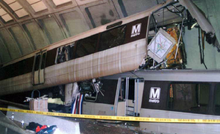This article needs additional citations for
verification. (April 2010) |


In a railway accident, telescoping occurs when the underframe of one vehicle overrides that of another, and smashes through the second vehicle's body. The term is derived from the resulting appearance of the two vehicle bodies: the body of one vehicle may appear to be slid inside the other like the tubes of a collapsible telescope – the body sides, roof and underframe of the latter vehicle being forced apart from each other. [1]
Telescoping often results in heavy fatalities if the cars telescoped are fully occupied. The car riding on top will often be destroyed by the structure of the car below, crushing those on board (although the physics of the incident may reverse the cars' roles). The chances of telescoping can be reduced by use of anticlimbers and other structural systems which direct crash energy and debris away from the passenger and crew areas. [2] One such energy absorbing system is the Green Buffer, winners of the 2023 Swedish Steel Prize, [3] where a collapsing steel structure in the buffers dissipate energy similarly to the crumple zones used in the automotive industry.
Accidents where telescoping occurred are numerous and include:
- 1864 Shohola train wreck
- 1888 Mud Run disaster
- 1928 Times Square derailment
- 1945 Michigan train wreck
- 1947 Camp Mountain rail accident
- 1952 Harrow and Wealdstone rail crash
- 1957 Lewisham rail crash
- 1962 Rail accidents in Winsford
- 1970 Benavídez rail disaster
- 1972 Chicago commuter rail crash
- 1981 Seer Green rail crash
- 1987 Bintaro train crash
- 1990 Ursus rail crash
- 2008 Chatsworth train collision
- 2009 Washington Metro train collision
- 2012 Buenos Aires rail disaster [4]
To reduce the chance of telescoping, rail and tramway vehicles are often provided with an anticlimber: a horizontally ridged plate at the end of the chassis, which in a collision will engage with the anticlimber on the next car.
Gallery
-
The aftermath of the June 2009 Washington Metro train collision
-
The aftermath of the 1898 St Johns rail accident, where the rear two carriages of a passenger train were telescoped by being hit at 8 mph (13 km/h) by a following train.
-
Cars involved in the Mud Run disaster, October 10, 1888
See also
References
- ^ Solomon, Brian (2001). The Heritage of North American Steam Railroads. London: Amber Books. p. 101. ISBN 1-897884-75-3.
- ^ Tyrell, David and Jeff Gordon (June 2013). "Crash Energy Management An Overview of Federal Railroad Administration Research" (PDF). onlinepubs.trb.org/. TR News. Retrieved December 14, 2022.
- ^ "Green Buffers wins Swedish Steel Prize 2023". Steelprize.com. Retrieved 24 May 2023.
- ^ Einat Rozenwasser (25 February 2012). "Un operativo que resultó eficaz pero que ahora revela fallas". Clarín (in Spanish). Retrieved 25 February 2012.


